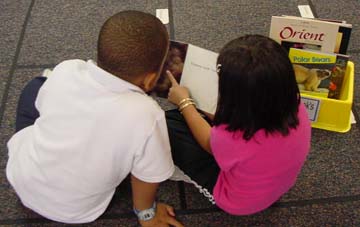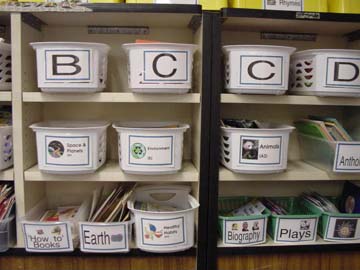|
Teacher Feature...
Partner Book Talk Procedures
Kindergarten Precursor to Literature Circles
by Sandy Hamilton
Our Partner Book Talk is an extension of our Read Aloud with accountable talk. After the Read Aloud, sets of two children pick a basket of books from around the room. Book baskets are sorted by genre, author, current theme, reading level, topic etc. The chart we created using digital pictures of the students says:

- Pick a basket of books.
- Find a spot to sit. (Students are allowed to sit almost anywhere in the room.)
- Decide how the books are the same.
- Pick one book to "read." (They have to discuss, agree, and share one book)
- Read it, talk about it, and tell your partner what you already know. (About the topic, the author etc.)
- Use a small 6-inch voice.

When we finish Partner Book Talk they return the baskets and meet again at the carpet where they share what they discussed:
- How their partner helped them understand the book/topic better, or
- How the books were similar, or
- How they found a certain element that we had been learning about (Table of contents, labels, speech bubbles etc.)
Many of these books are above their reading level so they are looking at pictures, discussing story lines, doing a picture walk, finding familiar sight words etc. Many are non-fiction books so they are discussing what they already know about the pictures. The focus is on talking about books not so much reading to your partner. This activity is a precursor to Literature Circles.
When we are teaching a feature of non-fiction the students might be asked to find that feature. For example, when we learned about the glossary they were asked to find information from the glossary. For this work I would give out specific sets of books, not let them just choose any basket.

If we had been discussing setting during our Read Aloud they would be looking for evidence of the setting in their book.
Another time we do Partner Book Talk is at the end of each week. I display all the books we read as a class that week. I ask them to think about which one was their favorite. I ask them to think about why they liked that book better than the other books. I ask them to think about what they could say to their partner that might convince them to pick the book you like. They turn and talk to their partner, telling them the title of their favorite book, the reason they liked that book, and why their partner should vote for that book too. Then we give children a turn to vote for their favorite book. We discuss the reason why they liked that book better and what they heard from their partner that might have changed their mind. We record our favorite book in our Reading Log. Then we compare this week's winning book to last week's book and vote again.
|

